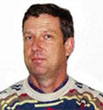 Jan Smit
Jan Smit
To the uninitiated reader of the Chicxulub Debate, it may have appeared futile - the participants did not agree in the end! But I think that is not true. The debate has served an important purpose. It has brought out the main controversies, and what geological data are all about. Geological data are messy, by necessity. There is always a devil in paradise. There are nowhere long, detailed, uninterrupted, undisturbed, well preserved sedimentary sequences with high sedimentation rates (=resolution), which remain in the same facies throughout their lateral extent. Even the most continuous cores from the Ocean Drilling Program are interrupted, not complete and disturbed. It is simply not possible to collect a series of samples and compare them on a one-to-one basis at face value. Each sample a geologist takes is mingled with biases; each has a long history before one can read the original record correctly.
Time to review the evidence
Consequently, what we call evidence has to be taken with a grain of salt, because such evidence remains a personal interpretation. Take, for instance, our debate on the 'burrows' in the clastic deposits at the K/T boundary. For Keller it refutes the tsunami hypothesis. But before you can chalk this up as a strong point in case, a tremendous number of questions have to be resolved first. Is it a burrow or an artefact? Where does it come from? Where does it occur? How many are there? How quickly was it made? What animal lived in it?
The same goes for the foraminifera above the clastic beds in and outside Chicxulub crater. Are they in situ? Are they reworked? Are they identified correctly? Is the type of rock they occur in compatible? Are they made of dolomite or calcite?
Time to review the peers
How does peer review deal with such evidence? With the enormous amount of data and papers nowadays reviewers simply lack the time and expertise to screen all the evidence adequately. The peer review system is ready for revision, and internet debates such as these may play an important role in the change. The European Geosciences Union EGU is already doing this. Papers appear on the web for a few months before publication, for all to scrutinise, besides classical peer review. A debate such as this may call for another type of referee. One who independently checks the validity of data.
Mike Simmons (Posted 7.01.04) has taken up the challenge, and I gladly accept his offer and would like to turn my polished thin sections over to him (under supervision of the Geological Society?) to scrutinise. It is unfortunate that Keller evades such test so far, and offers instead to look at other sections (with new problems) or to questionable data (Ward et al., 1995) that are irreproducible, because all samples from that core are lost.
Testability
Luis Alvarez once said that what made the impact theory for him as physicist so attractive, is its testability, and the possibility of rejection. At the start of the impact extinction theory in 1978, a number of predictions were made, that could be tested. Theories are strengthened when their predictions come true, and what came true is:
- The global occurrence of only one ejecta layer, synchronous in time
- The finding of impact shock markers such as shocked quartz in the ejecta layer
- The occurrence Ni-rich spinels, microkrystites and impact glass in the ejecta layer
- The same platinum metal abundance ratios in the ejecta layer as in meteorites
- The finding of tiny diamonds
- The finding of chromium isotope ratios in the ejecta layer the same as known from carbonaceous chondrite meteorites, but unknown from any source on Earth (not mentioned in the last contribution by Tim Reston)
- The finding of a single ejecta layer on land, just above the last dinosaur footprints
An all encompassing, elegant theory is preferred by most scientists - Occam's razor's principle if you will. If one theory explains all your data, is this theory not preferable above separate theories each explaining part of the problem? Why is plate tectonic theory so successful? Because it explains geological phenomena in one coherent, encompassing theory that were explained by many mechanisms before. Why are physicists looking for the Grand Unifying Theory? Why is string theory so appealing? Because physicists believe it may bridge the gap, and even unify two separate theories.
Impact - adhesive?
Why is the Impact extinction theory appealing? Because up to now it explains all the phenomena at the K/T boundary in one coherent, elegant theory, while Keller prefers to explain the different phenomena each by different mechanisms.
If the tests for the impact theory fail to support it, we should abandon it. But so far I believe we can explain all the known data within the single impact theory, and the purported data accumulated by Keller to show otherwise, will not hold when critically evaluated. But that is not mine to decide, others will make that decision for her.
Amsterdam, Netherlands January 2004
Back to Debate front page
Ward, W. C., Keller, G., Stinnesbeck, W., and Adatte, T., 1995, Yucatan subsurface stratigraphy: Implications and constraints for the Chicxulub impact: Geology, v. 23, p. 873-877.